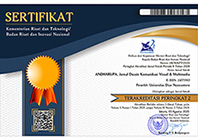Pengembangan Techno Virtual Berbasis Website sebagai Media Pembelajaran Rekayasa Visual Blender 3D bagi Mahasiswa Desain Produk
DOI:
https://doi.org/10.33633/andharupa.v5i01.1965Abstract
AbstrakPenelitian terapan ini bertujuan untuk mengembangkan model pembelajaran alih media teknologi maya (techno virtual) rekayasa visual Blender 3D bagi mahasiswa berbasis website learning. Secara operasional penelitian ini akan menilai apakah melalui techno virtual, materi bahan ajar dapat dengan mudah diterima dan membantu para mahasiswa dalam menyelesaikan tugasnya. Penelitian ini menggunakan pendekatan deskriptif kuantitatif, yaitu penelitian yang mendasarkan atas pengolahan statistik, dan percobaan terkontrol dengan sampel mahasiswa desain produk. Metode analisis yang digunakan yaitu analisis inferensia berdasarkan sample test. Untuk menguji tingkat kepuasan user dan baik tidaknya layanan fasilitas yang lain, maka teknik Important Performance Analysis (IPA) digunakan untuk mengukur tingkat layanan website. Hasil penelitian menunjukkan bahwa website learning berbasis techno virtual dapat diterima secara kognitif dan menstimuli psikomotorik sehingga sangat membantu dan memudahkan mahasiswa dalam menyelesaikan tugas rekayasa visual Blender 3D. Kata Kunci: Blender 3D, mahasiswa, techno virtual, website learning AbstractThis applied research aims to develop a learning model of virtual media technology transfer (Techno Virtual) visual engineering Blender 3D for student-based website learning. Operationally this research will assess whether the material of teaching materials can be easily accepted through virtual techno, and help students in completing their assignments. This research uses quantitative descriptive approach, that is research based on statistical processing and controlled experiment with the sample of product design student. The analytical method used is inferencing analysis based on sample test. The Important Performance Analysis (IPA) technique is used to measure the level of website services and the level of user satisfaction. The results showed that virtual technology-based learning website can be accepted cognitively and stimulate psychomotor so it is very helpful and easier for students in completing the assignments of visual engineering Blender 3D. Keywords: Blender 3D, student, techno virtual, website learningReferences
Allen, M. (2013). Michael Allen’s Guide to E-learning. Canada: John Wiley & Sons.
Chandrawati, Sri Rahayu (2010), Pemanfaatan E-learning dalam Pembelajaran. No 2 Vol. 8. http://jurnal.untan.ac.id
Eggen, Paul & Kauchak, Don. (2012). Strategi dan Model Pembelajaran: Mengajarkan Konten dan Keterampilan Berfikir. Jakarta: Indeks.
Machmud, Muslimin. (2016). Kerangka Sistematika Format Penulisan Tugas Akhir. Malang: Penerbit Selaras
Martilla & J. C. James, (1977), “Importance Performance Analysis,†Journal of Marketing
Maryati, Kun. (2015), Sosiologi: Jilid 3. Jakarta: ESIS. Hal 103. ISBN 979-734-529-7, 9789797345297.
Rahayu, Iin Tri, dan Ardani, Tristiadi Ardi, (2004). Observasi dan Wawancara. Malang: Bayumedia.
Reily, M. (2017). Teknologi Informasi di Indonesia Peringkat 111 dari 176 Negara. Retrieved February 27, 2019, from https://katadata.co.id/berita/2017/12/15/teknologi-informasi-di-indonesia-peringkat-111-dari-176-negara
Rouse, M. (2015). What is virtual learning environment (VLE) or managed learning environment (MLE)? - Definition from WhatIs.com. Retrieved February 27, 2019, from https://whatis.techtarget.com/definition/virtual-learning-environment-VLE-or-managed-learning-environment-MLE
Rusman & Ruhimat, Toto. 2011. Layanan Pembelajaran Berbasis E-Learning Untuk Pemerataan Akses Dan Peningkatan Mutu Pendidikan. diakses Senin, 28 Februari 2011
Sugiyono (2012) Metodologi Penelitian Pendidikan Pendekatan Kuantitatif, Kualitatif dan R & D. Bandung: CV. Alfabeta
Syamsuddin, dkk. (2011) Metode Penelitian Pendidikan Bahasa. Bandung: PT. Remaja Rosdakarya.
Utama, Yadi . (2007). Teknik Pemrograman Web Service PHP Dengan Menggunakan SOAP dan WSDL, jbptunikompp-gdl-zachman-25650-12-webserv-l.doc
Downloads
Published
Issue
Section
License
Copyright (c) 2019 ANDHARUPA: Jurnal Desain Komunikasi Visual & Multimedia

This work is licensed under a Creative Commons Attribution 4.0 International License.
Authors who publish with this journal agree to the following terms:
- Authors retain copyright and grant the journal right of first publication with the work simultaneously licensed under a Creative Commons Attribution License that allows others to share the work with an acknowledgment of the work's authorship and initial publication in this journal.
- Authors are able to enter into separate, additional contractual arrangements for the non-exclusive distribution of the journal's published version of the work (e.g., post it to an institutional repository or publish it in a book), with an acknowledgment of its initial publication in this journal.
- Authors are permitted and encouraged to post their work online (e.g., in institutional repositories or on their website) prior to and during the submission process, as it can lead to productive exchanges, as well as earlier and greater citation of published work (See The Effect of Open Access).















